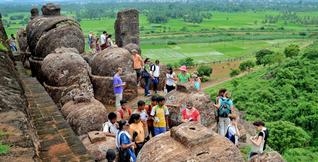Scores of villagers visit the Buddhist sites of Bojjannakonda and Lingalametta on Kanuma day

Surrounded by lush green fields, the twin hills of Bojjannakonda and Lingalametta are the remains of a monastery that date back to the third century BC. But that is not the only significance of these sites.
The hills are also a crucial link to an era when Buddhism flourished in this part of the country. The site was discovered and excavated by a British civil servant, Alexander Rea, in the year 1909.
Situated at a distance of 40 kilometres from the city, the stones and structures of Bojjannakonda scream to tell a story that lies hidden within it. Bojjannakonda was a place of worship for the monks.
The monastery is located on top of the site and surrounding it are the places where the monks lived. A gold coin belonging to the Samudra Gupta period, copper coins of the Chalukya king Kubja Vishnu Vardhan, coins of Andhra Satavahanas and pottery were discovered at the site.
An interesting feature of the hill is that it has seen all the three forms of Buddhism – the original Theravada, where in Lord Buddha was looked upon as a teacher; Mahayana, where Buddha was treated as a supra natural figure; and finally Vajrayana, where tantrism and a pantheon of gods entered the Buddhist ritual. Buddhism also seems to have seamlessly merged into Hinduism, for there is the image of Ganesha in one of the caves of the hill.
While in Lingalametta, every inch of the site is studded with votive stupas (structures that worshipers would donate and construct after their wishes were fulfilled).
For several years now, a strange ritual takes place on the day of Kanuma, observed on the third day of Sankranti. Lakhs of villagers visit these Buddhist sites on this day as an age-old practice. “While this custom has been observed for many years, today it has taken the form of a picnic and outing in the name tradition and vandalise these structures,” says former covernor of INTACH-Vizag Rani Sarma.
INTACH has been striving to create awareness about this issue from the past couple of years and sought help of the government officials. With the support of the District Collector,
NSS volunteers from different institutions have been instructed to monitor the situation this year and prevent any damage to the heritage structures.
Interestingly, after offering prayers at Bojjannakonda, the villagers proceed to Lingalametta and throw stones on the hill, a practice done to “driving the devil” from the hill. “The damage done to these sites over these years is enormous. At Lingalametta, the votive stupas are all broken,” she says.
NIVEDITA GANGULY
source: http://www.thehindu.com / The Hindu / Home> Features> Metro Plus / by Nivedita Ganguly / january 11th, 2014